Sales of sports nutrition products in Latin America are estimated at USD 2.1 billion in 2025, with projections indicating a rise to USD 4.8 billion by 2035, reflecting a CAGR of approximately 8.6% over the forecast period. This growth reflects both a broadening consumer base and increased per capita consumption in key urban centres across the region. The rise in demand is linked to shifting fitness culture, growing awareness of protein supplementation, and evolving convenience trends among athletes and fitness enthusiasts.
By 2025, per capita consumption in leading Latin American countries such as Brazil, Mexico, and Argentina averages between 2.1 to 2.4 kilograms, with projections reaching 3.2 kilograms by 2035. São Paulo leads among metropolitan areas, expected to generate USD 380 million in sports nutrition sales by 2035, followed by Mexico City (USD 295 million), Buenos Aires (USD 187 million), Lima (USD 142 million), and Bogotá (USD 98 million).
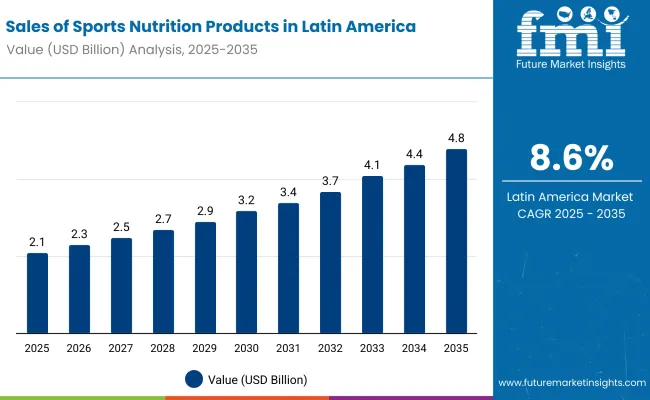
The largest contribution to demand continues to come from ready-to-drink sports nutrition beverages, which are expected to account for 62% of total sales in 2025, owing to strong convenience appeal, immediate consumption benefits, and growing retail presence. By distribution channel, specialty fitness stores represent the dominant retail format, responsible for 47% of all sales, while e-commerce platforms and pharmacies are expanding rapidly.
Consumer adoption is particularly concentrated among young urban professionals and fitness-conscious millennials, with disposable income and urban lifestyle emerging as significant drivers of demand. While price sensitivity remains a consideration, the average price gap between RTD and powder formats has narrowed from 35% in 2020 to 22% in 2025. Continued improvements in manufacturing scale and local production capabilities are expected to accelerate affordability and access across middle-income households. Regional disparities persist, but per capita demand in emerging markets like Colombia and Peru is narrowing the gap with traditionally strong markets in Brazil and Mexico.
The sports nutrition segment in Latin America is classified across several categories. By product format, the key categories include ready-to-drink beverages, protein powders, energy bars, pre-workout supplements, and recovery drinks. By distribution channel, the segment spans specialty fitness stores, pharmacies, e-commerce platforms, supermarkets, and convenience stores. By protein source, formulations include whey protein, casein protein, plant-based proteins, and amino acid complexes.
By consumer profile, the segment covers fitness enthusiasts, professional athletes, recreational gym users, endurance sports participants, and health-conscious millennials. By country, markets such as Brazil, Mexico, Argentina, Colombia, and Peru are included, along with coverage across all major Latin American markets. By city, key metro areas analyzed include São Paulo, Mexico City, Buenos Aires, Lima, and Bogotá.
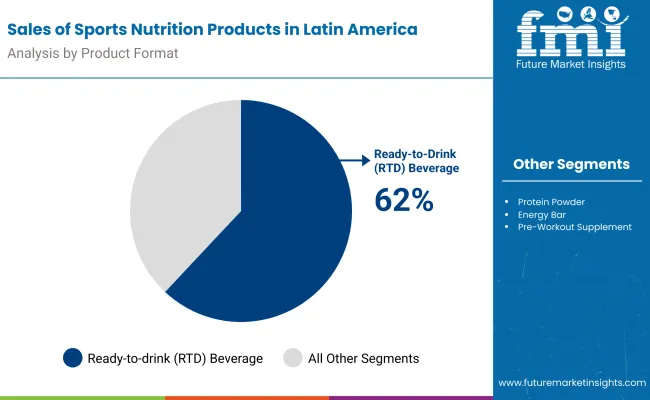
Ready-to-drink sports nutrition beverages are projected to dominate sales in 2025, supported by convenience factor, immediate consumption appeal, and growing shelf presence in mainstream retail. Other formats such as powders, bars, and supplements continue to serve distinct consumer needs and usage occasions.
Ready-to-drink beverages are expected to hold a 62% value share in 2025, driven by high convenience appeal among busy professionals, strong performance in convenience channels, and consumer preference for grab-and-go nutrition solutions during workout sessions and throughout the day.
Protein powders maintain significant presence among serious fitness enthusiasts and bodybuilders, supported by cost-per-serving advantages and customizable dosing, particularly strong in specialty fitness retail and online channels.
Energy bars and solid formats are showing steady growth in on-the-go consumption occasions, with 7% annual growth tied to portable nutrition needs and increasing availability in mass retail and convenience stores.
Pre-workout and recovery supplements appeal to performance-focused consumers and are expanding through specialized channels and subscription services, while still representing a premium segment with higher margins and dedicated user base.
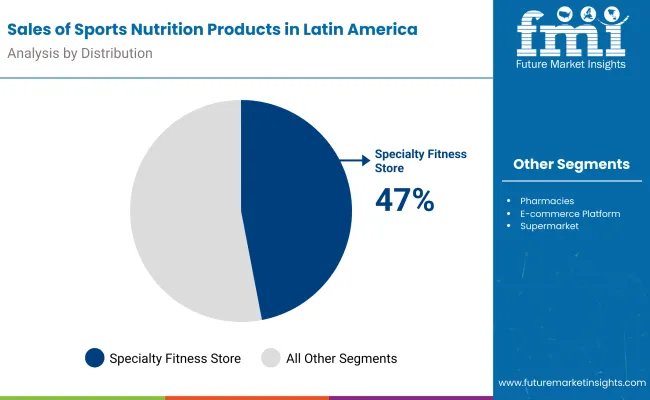
Sports nutrition products in Latin America are distributed through a mix of specialized retail and mainstream sales channels. Specialty fitness stores are expected to remain the primary point of sale in 2025, followed by pharmacies and e-commerce platforms. Distribution strategies are evolving to match consumer shopping behavior, with growth coming from both traditional and digital formats.
Specialty fitness stores are projected to account for 47% of total sales in 2025, supported by expert consultation, product education, and strong relationships with fitness communities in gyms and training centers across major metropolitan areas.
Pharmacies and health stores are expanding their role through trusted health positioning and convenient locations, targeting health-conscious consumers seeking quality assurance and professional guidance in supplement selection.
E-commerce platforms are forecast to grow at over 15% CAGR (2025 to 2035), fueled by subscription models, bulk purchasing options, and direct-to-consumer brands offering exclusive products and competitive pricing in urban markets.
Supermarkets and mass retailers are increasingly adding sports nutrition sections, particularly for RTD beverages and mainstream protein products, appealing to casual fitness users and convenience-focused consumers.
Convenience stores in urban corridors are testing single-serve RTD products and energy bars, targeting commuters and active individuals seeking immediate nutrition solutions during travel and daily activities.
Sports nutrition products in Latin America utilize various protein bases, selected for bioavailability, taste profile, cost considerations, and consumer preferences. Whey protein remains the most widely used protein input, though plant-based alternatives are gaining momentum among health-conscious and environmentally aware consumers.
Whey protein, including concentrates and isolates, continues to anchor most sports nutrition formulations due to its complete amino acid profile, fast absorption rate, and proven performance benefits in both RTD and powder formats.
Casein protein serves the slow-release nutrition segment, favored for recovery and nighttime consumption, particularly strong in powder formats among serious athletes and bodybuilders.
Plant-based proteins including pea, rice, and hemp alternatives are emerging as key options for vegan and lactose-intolerant consumers, supported by growing environmental consciousness and dietary diversity trends.
Amino acid complexes and BCAAs offer targeted nutrition for specific performance goals, widely used in pre-workout and recovery formulations, adding functional benefits and premium positioning.
Blended protein sources combining multiple inputs are increasingly used in RTD beverages and meal replacement products, offering balanced nutrition profiles and improved taste characteristics.
The sports nutrition category appeals to a diverse consumer base across age groups, fitness levels, and lifestyle preferences. While motivations vary from performance enhancement to general wellness, demand is concentrated among five key demographic clusters. Each group brings distinct purchase behaviors, channel preferences, and product expectations.
Fitness enthusiasts represent a core consumer group prioritizing performance and results, this segment tends to purchase protein powders and specialized supplements from fitness stores and online platforms, responding well to scientific claims and professional endorsements.
Health-conscious millennials show high interest in clean-label and natural formulations, this group actively seeks plant-based options, minimal additives, and sustainable packaging, often purchasing across e-commerce and pharmacy channels.
Professional athletes and serious trainers demand high-quality, performance-tested products with specific nutritional profiles, their purchasing is influenced by sports nutrition specialists and team recommendations, favoring premium brands and proven formulations.
Recreational gym users experiment with mainstream products across multiple formats, particularly RTD beverages and convenient bars, their purchases are driven by convenience, taste, and value considerations in accessible retail locations.
Casual wellness consumers, including those managing weight and general health goals, increasingly adopt sports nutrition products for daily supplementation, demonstrating preference for familiar brands and approachable formats in mainstream retail settings.
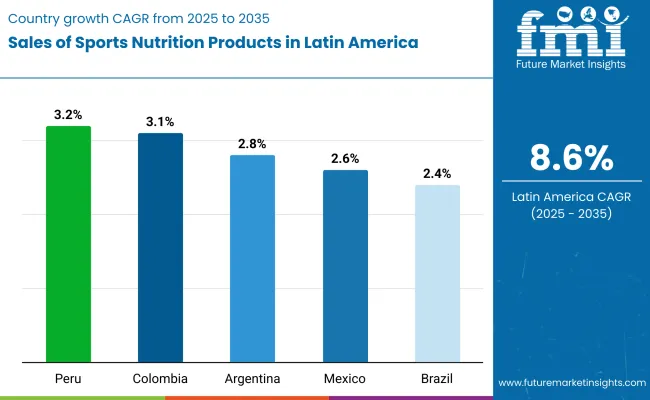
Sports nutrition sales will not grow uniformly across every Latin American country. Rising fitness culture adoption and faster per capita consumption growth in emerging markets give Peru and Colombia a measurable edge, while mature markets such as Brazil and Mexico expand more steadily from a higher base. The table below shows the compound annual growth rate (CAGR) each of the five largest countries is expected to record between 2025 and 2035.
| Country | CAGR (2025 to 2035) |
|---|---|
| Peru | 3.2% |
| Colombia | 3.1% |
| Argentina | 2.8% |
| Mexico | 2.6% |
| Brazil | 2.4% |
Between 2025 and 2035, demand for sports nutrition products is projected to expand across all major Latin American countries, but the pace of growth will vary based on economic development, fitness culture penetration, and baseline consumption levels. Among the top five countries analyzed, Peru and Colombia are expected to register the fastest compound annual growth rates of 3.2% and 3.1% respectively, outpacing more established markets. This acceleration is underpinned by growing middle-class populations, increasing gym membership rates, and expanding retail presence of international sports nutrition brands. In both countries, per capita consumption is projected to rise from 1.8 kg in 2025 to 2.6 kg by 2035, closing the gap with higher-consumption markets such as Brazil and Mexico.
Argentina is forecast to grow at a CAGR of 2.8% over the same period, supported by strong fitness culture and increasing disposable income among urban populations. The country maintains established retail networks with widespread access to both international and local sports nutrition brands across Buenos Aires and other major cities.
Mexico and Brazil, while maintaining the highest overall sales in absolute terms, are expected to grow at CAGRs of 2.6% and 2.4% respectively, reflecting market maturity and higher baseline consumption levels. Both countries already exhibit well-developed sports nutrition ecosystems with extensive product availability and established consumer habits.
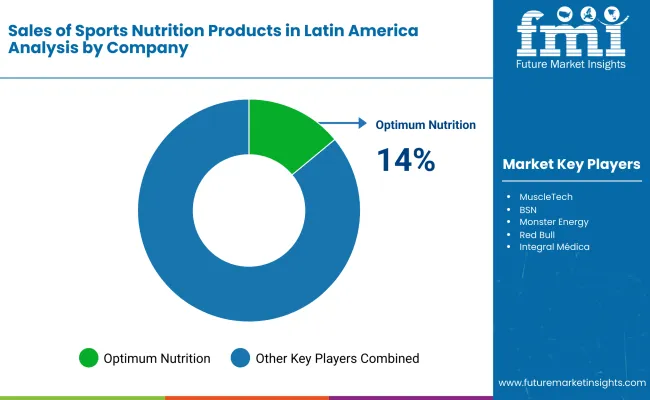
The competitive environment is characterized by a mix of multinational supplement manufacturers and regional players focusing on local taste preferences and pricing strategies. Distribution reach and brand recognition remain decisive success factors, with leading suppliers maintaining presence across multiple channels and countries throughout the region.
Optimum Nutrition maintains market leadership through premium positioning and wide product portfolio, leveraging Gold Standard Whey protein's global reputation and strong presence in specialty fitness channels across Brazil, Mexico, and Argentina.
MuscleTech, owned by Iovate Health Sciences, benefits from aggressive marketing campaigns and partnerships with fitness influencers, particularly strong in powder formats and pre-workout supplements across urban markets.
BSN (Bio-Engineered Supplements and Nutrition) focuses on innovative formulations and eye-catching packaging, building strong following among younger demographics through social media marketing and gym partnerships.
Monster Energy and Red Bull have successfully expanded beyond energy drinks into sports nutrition RTD beverages, leveraging massive brand recognition and extensive distribution networks in convenience and retail channels.
Local and regional players including Brazilian brands like Integral Médica and Mexican companies like Genomma Lab are gaining share through competitive pricing, local flavor preferences, and targeted marketing to price-sensitive consumer segments.
Private-label programs at major pharmacy chains and supermarkets are expanding assortment at price points 15-20% below branded equivalents, creating pressure on smaller suppliers while supporting category growth among mainstream consumers.
| Attribute | Details |
|---|---|
| Study Coverage | Latin America sales and consumption of sports nutrition products from 2020 to 2035 |
| Base Year | 2025 |
| Historical Data | 2020 |
| Forecast Period | 2025 to 2035 |
| Units of Measurement | USD (sales), Metric Tonnes (volume), Kilograms per capita (consumption) |
| Geography Covered | Brazil, Mexico, Argentina, Colombia, Peru, Chile, Venezuela, Ecuador, Uruguay, Paraguay |
| Top Countries Analyzed | Brazil, Mexico, Argentina, Colombia, Peru |
| Top Cities Analyzed | São Paulo, Mexico City, Buenos Aires, Lima, Bogotá |
| By Product Format | RTD beverages, Protein powders, Energy bars, Pre-workout supplements, Recovery drinks |
| By Distribution Channel | Specialty fitness stores, Pharmacies, E-commerce, Supermarkets, Convenience stores |
| By Protein Source | Whey, Casein, Plant-based, Amino acids, Blended proteins |
| By Consumer Profile | Fitness enthusiasts, Professional athletes, Recreational users, Health-conscious millennials, Casual wellness consumers |
| Metrics Provided | Sales (USD), Volume (MT), Per capita consumption (kg), CAGR (2025 to 2035), Share by segment |
| Price Analysis | Average unit prices by product format and country |
| Competitive Landscape | Company profiles, distribution strategies, brand positioning, local vs international |
| Forecast Drivers | Fitness culture growth, urbanization trends, disposable income growth, retail expansion |
By 2035, total Latin America sales of sports nutrition products are projected to reach USD 4.8 billion, up from USD 2.1 billion in 2025, reflecting a CAGR of approximately 8.6%.
Ready-to-drink beverages hold the leading share, accounting for approximately 62% of total sales in 2025, followed by protein powders and energy bars.
Peru and Colombia lead in projected growth, registering CAGRs of 3.2% and 3.1% respectively between 2025 and 2035, due to expanding fitness culture and rising disposable income.
Specialty fitness stores are the dominant sales channel (47% share in 2025), but e-commerce platforms are growing at double-digit CAGR, especially in urban regions.
Major players include Optimum Nutrition, MuscleTech, BSN, Monster Energy, and Red Bull, with growing competition from local brands like Integral Médica and Genomma Lab.






Our Research Products

The "Full Research Suite" delivers actionable market intel, deep dives on markets or technologies, so clients act faster, cut risk, and unlock growth.

The Leaderboard benchmarks and ranks top vendors, classifying them as Established Leaders, Leading Challengers, or Disruptors & Challengers.

Locates where complements amplify value and substitutes erode it, forecasting net impact by horizon

We deliver granular, decision-grade intel: market sizing, 5-year forecasts, pricing, adoption, usage, revenue, and operational KPIs—plus competitor tracking, regulation, and value chains—across 60 countries broadly.

Spot the shifts before they hit your P&L. We track inflection points, adoption curves, pricing moves, and ecosystem plays to show where demand is heading, why it is changing, and what to do next across high-growth markets and disruptive tech

Real-time reads of user behavior. We track shifting priorities, perceptions of today’s and next-gen services, and provider experience, then pace how fast tech moves from trial to adoption, blending buyer, consumer, and channel inputs with social signals (#WhySwitch, #UX).

Partner with our analyst team to build a custom report designed around your business priorities. From analysing market trends to assessing competitors or crafting bespoke datasets, we tailor insights to your needs.
Supplier Intelligence
Discovery & Profiling
Capacity & Footprint
Performance & Risk
Compliance & Governance
Commercial Readiness
Who Supplies Whom
Scorecards & Shortlists
Playbooks & Docs
Category Intelligence
Definition & Scope
Demand & Use Cases
Cost Drivers
Market Structure
Supply Chain Map
Trade & Policy
Operating Norms
Deliverables
Buyer Intelligence
Account Basics
Spend & Scope
Procurement Model
Vendor Requirements
Terms & Policies
Entry Strategy
Pain Points & Triggers
Outputs
Pricing Analysis
Benchmarks
Trends
Should-Cost
Indexation
Landed Cost
Commercial Terms
Deliverables
Brand Analysis
Positioning & Value Prop
Share & Presence
Customer Evidence
Go-to-Market
Digital & Reputation
Compliance & Trust
KPIs & Gaps
Outputs
Full Research Suite comprises of:
Market outlook & trends analysis
Interviews & case studies
Strategic recommendations
Vendor profiles & capabilities analysis
5-year forecasts
8 regions and 60+ country-level data splits
Market segment data splits
12 months of continuous data updates
DELIVERED AS:
PDF EXCEL ONLINE
Latin America Sports Nutrition Market Insights – Size, Share & Forecast 2025-2035
Latin America Sports Drink Market Analysis – Demand, Size & Forecast 2025–2035
Latin America Oral Clinical Nutrition Supplement Market Report – Growth, Demand & Forecast 2025-2035
Latin America Joint Compound Industry Analysis Size and Share Forecast Outlook 2025 to 2035
Latin America In-mold Labels Market Size and Share Forecast Outlook 2025 to 2035
Latin America Rigid Industrial Packaging Market Size and Share Forecast Outlook 2025 to 2035
Latin America Hand Sanitizer Market Size and Share Forecast Outlook 2025 to 2035
Latin America Hand Soap Market Size and Share Forecast Outlook 2025 to 2035
Latin America Hydraulic Filtration Market Size and Share Forecast Outlook 2025 to 2035
Latin America Automotive HVAC Market Size and Share Forecast Outlook 2025 to 2035
Latin America Frozen Ready Meals Market Insights – Demand & Forecast 2025–2035
Latin America Fish Protein Market Trends – Size, Growth & Forecast 2025–2035
Latin America Aqua Feed Additives Market Trends – Growth & Forecast 2025–2035
Latin America Collagen Peptide Market Report – Trends, Size & Forecast 2025–2035
Latin America Bubble Tea Market Outlook – Growth, Trends & Forecast 2025–2035
Latin America Shrimp Market Report – Trends, Growth & Forecast 2025–2035
Latin America Animal Feed Alternative Protein Market Analysis – Growth & Forecast 2025–2035
Latin America Cultured Wheat Market Outlook – Growth, Demand & Forecast 2025–2035
Latin America Fructo-Oligosaccharides Market Report – Trends & Forecast 2025–2035
Latin America Starch Derivatives Market Outlook – Growth, Demand & Forecast 2025–2035

Thank you!
You will receive an email from our Business Development Manager. Please be sure to check your SPAM/JUNK folder too.
Chat With
MaRIA